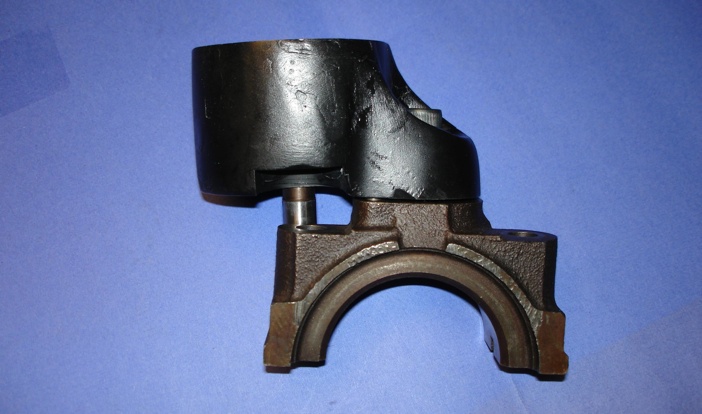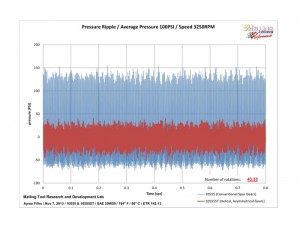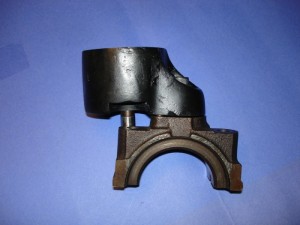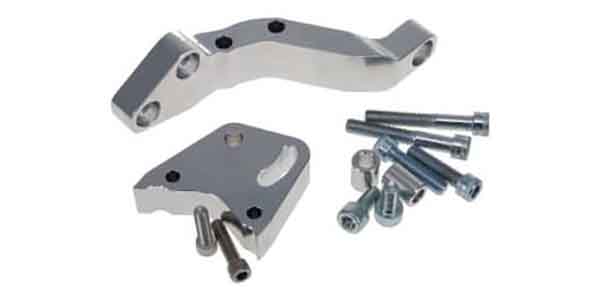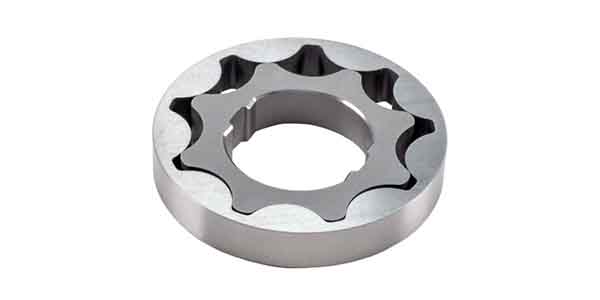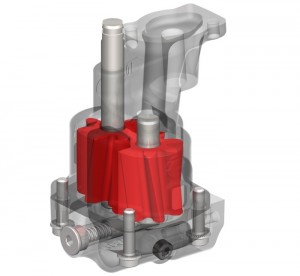 Choosing a replacement oil pump for an engine you are building or modifying is a process that requires some thought. Original equipment oil pumps are usually adequate for most stock applications – but some are not, especially if an engine is being modified for more power or RPMs, or the stock bearing clearances are being altered to be more compatible with a heavier racing oil (like 15W-40 or higher) or a thinner viscosity synthetic motor oil (like 0W-20, 0W-40 or 5W-20).
Choosing a replacement oil pump for an engine you are building or modifying is a process that requires some thought. Original equipment oil pumps are usually adequate for most stock applications – but some are not, especially if an engine is being modified for more power or RPMs, or the stock bearing clearances are being altered to be more compatible with a heavier racing oil (like 15W-40 or higher) or a thinner viscosity synthetic motor oil (like 0W-20, 0W-40 or 5W-20).
The oil flow and pressure generated by an oil pump needs to be closely matched to the application. The old rule of thumb that an engine needs about 10 PSI of oil pressure for every 1,000 RPM is still valid for many stock engines as well as many modified engines, but there are exceptions. It takes power to turn an oil pump, so the more flow and pressure the pump develops, the more power it saps from the engine.
Most engines don’t really require a lot of oil pressure at idle. Ten to 15 PSI or even less in some cases is adequate to keep the bearings, cam and valvetrain lubricated. A gauge reading of 30 PSI at idle looks good to many people, and some want to see even higher numbers. But most engines don’t really need that much pressure at idle or low RPM. It’s a waste of pumping effort and horsepower.
Many NASCAR teams run as little as 5 PSI for every 1,000 RPM, or even less. Of course, NASCAR engines don’t spend much time idling and mostly run flat out at high RPM. Consequently, the pump’s output volume and pressure can be minimized to deliver just enough oil to keep the engine lubed without wasting excessive power to drive the pump.
By comparison, a street motor spends a lot of time idling and running at low RPM, so the oil pump has to deliver good flow and pressure at all engine speeds. Parasitic horsepower draw is less of a concern in a street motor, so that’s why many street pumps are set to over-deliver oil to the engine. Most people see it as providing extra insurance against any unwanted drop in oil pressure that might damage the engine.
High Volume Pumps
Some people use high volume pumps to “fix” low idle oil pressure and/or valvetrain noise. A high volume pump can certainly be used for such purposes. But if an engine has a low idle oil pressure problem and/or valvetrain noise, there are other issues that need to be addressed such as loose or worn bearing clearances, pressure losses within the oiling system itself, possibly oil flow restrictions to the upper valvetrain, or worn valvetrain components.
On high mileage Ford 5.4L engines, for example, wear in the VVT cam phasers can set cam timing codes and turn on the
“Check Engine light.” Replacing the stock oil pump with a high volume pump can maintain good oil flow to the cam phasers and eliminate the codes.
On Chevy LS engines with active fuel management, replacing the stock oil pump with a high volume pump can eliminate the valvetrain clatter that occurs after a cold start because the lifters have bled down. GM’s fix for the problem was to redesign the lifters, but the cost to replace the lifters can run more than $1700 – so swapping the oil pump is often a more affordable fix for the cold start valvetrain clatter.
High volume oil pumps have taller gears and typically flow about 15 to 20 percent more oil than a comparable stock pump. On some applications, a high flow pump is absolutely essential. Many late model engines with cylinder deactivation (such as Chevy LS 5.3L and 6.0L V8 engines, and Chrysler 5.7L Hemi) as well as those with VVT require more oil flow for the lifters and cam phasers so these parts can do the job properly.
A high volume oil pump is also necessary if you’re building a performance engine with looser clearances (say more than .0025˝ at the main and rod bearings with 20W-50 racing oil). On the other hand, if you are building an engine with tighter main and rod bearing clearances the engine won’t need as much oil volume and a stock capacity pump should work just fine.
Limitations of Stock Pumps
One of the limitations of all oil pumps is the problem of cavitation. At some speed, the gears inside the pump will be spinning faster than the oil can flow into and through the pump. When this limit is reached, small bubbles or voids along the trailing edges of the gears form, known as cavitation. This aerates the oil and causes the pump’s output to flat line or drop. For many stock, straight cut, twin spur gear oil pumps, cavitation can occur when the engine exceeds 5000 RPM. With front mounted or crankcase mounted gerotor style oil pumps, cavitation may occur at a somewhat higher RPM.
Cavitation is obviously something you want to minimize or avoid because of the drop in oil pressure it causes along with the possible risks diminished oil flow can have on the bearings and valvetrain. Oil pump manufacturers have developed various pump designs that can reduce cavitation at higher engine speeds. One such trick is to enlarge the oil pump inlet port and use a larger diameter pickup tube (say 3/4-inch instead of 5/8-inch). This allows oil to flow more easily into the pump to keep up with the increasing speed of the gears. Another modification is that some racing pumps split the inlet stream into two channels and route half to each side of the gears.
Internal and external oil leakage at the oil pump are additional issues that can hurt oil flow and pressure. A worn pump or one with sloppy internal clearances obviously won’t pump as efficiently as a new pump with tight clearances. A pump requires a certain amount of internal clearance to accommodate thermal expansion so the pump doesn’t bind when it gets hot, but you don’t want more than .003 to .004˝ of clearance between the gears, housing and end plate, otherwise there will be too much internal pressure loss within the pump.
Tolerances within some OEM oil pumps can vary quite a bit. Chevy LS oil pumps are notorious for having sloppy clearances that can cause low, hot idle oil pressure problems. There can even be quite a bit of variation in stock Chevy small block and big block oil pumps as well.
On a small block Chevy oil pump, the acceptable tolerances are usually .003 to .005˝ of clearance between the teeth on the spur gears and the housing, with about .003˝ of backlash between the gears. The end clearance between the tops of the gears and the cover plate (with the gasket installed) may be .002 to as much as .006˝ of clearance.
Obviously, the tighter the clearances, the better the pumping efficiency. There has to be a little bit of clearance to compensate for thermal expansion when the pump and oil get hot, but not so much clearance that it allows excessive leakage between the gears and housing. Ideally, a new oil pump should have tolerances that are on the tight end of the range (.003˝ between the gears and housing, and .002 to .0025˝ between the gears and cover plate).
Unfortunately, some brand new pumps are not even in the acceptable range of tolerances – especially many low cost economy pumps from offshore suppliers. The only thing you can say about some of these pumps is that they are consistently inconsistent. One pump may measure right in the middle of the tolerances while another will be way out of specifications. Never assume a brand new pump is a tight pump that will prime and pump efficiently. Always check the clearances with a feeler gauge to make sure you are getting a good pump.
Some people will buy a small batch of new pumps, disassemble the pumps and select fit the internal parts in an attempt to minimize clearances. “Blueprinting” stock oil pumps by carefully mixing and matching gears and housings can optimize oil flow and performance. But what do you do with the leftover parts that are too loose to assemble a good pump?
Sloppy end clearances can always be cleaned up by surfacing the housing to lower its height (or surface the tops of the gears if there is insufficient clearance). But there’s not much you can do to tighten up the gear to housing clearances other than plating or coating the inside of the pump housing.
A die grinder can be used to carefully debur, reshape and blend the oil inlet and outlet ports. This can improve oil flow into and out of the pump. But a better approach is to choose a performance oil pump that has already had the ports redesigned for optimum flow.
Front-mounted oil pumps like those on Chevy LS, Ford modular engines and the new Chrysler Hemi have some advantages and disadvantages compared to crankcase-mounted oil pumps. On the plus side, they are all gerotor style pumps that have better flow characteristics than twin, straight cut spur gear pumps. Front-mounted pumps are also driven directly off the crankcase, which means it rotates at engine speed, or twice the speed of a crankcase-mounted pump that is driven by a shaft geared to the camshaft or distributor. There’s no drive shaft to flex, twist, bend or break, and there’s no effect on spark timing in engines that use a distributor.
One of the disadvantages of a front-mounted oil pump is that it is mounted high and dry. Oil tends to drain out of the pump rather quickly when the engine is shut off, leaving the pump dry for the next start. The pump also has a relatively long pickup tube to connect it to the oil in the pan. Consequently, a front-mounted pump takes longer to self-prime and generate oil pressure following a cold start, especially with heavier viscosity oil. By comparison, most crankcase-mounted pumps are at least partially submerged in oil. This helps to retain oil inside the pump when the engine is shut off, and makes it much faster and easier to self-prime and build oil pressure when a cold engine is started. Because of these differences, front-mounted pumps typically work best when used with lower viscosity motor oils, and with larger diameter pickup tubes and less restrictive inlet screens.
Front-mounted pumps can also be tricky to center properly. If not perfectly centered on the crankshaft, the pump ears will be offset slightly when the engine is cranked over. This can wipe out the pump housing or even break off its mounting bolts in some cases. Shims are available for centering the pump gears on the crank when the pump is installed. One recommendation is to turn the engine up on end so it is resting on the flywheel before mounting the pump. If this is not done, the crank will settle to the bottom of the main bores in the block, putting it off-center. If the oil pump is then mounted with the crank in this position, the pump will no longer be centered when oil pressure lifts the crank off the main bearing surfaces – possibly damaging the pump. If the engine is in a vehicle and can’t be set up on end, another suggestion is to loosely mount the pump on the crankshaft, rotate the engine several times to center the pump, then tighten down its mounting bolts to keep it in place.
Another issue with front-mounted pumps is oil leakage between the pump housing and its cover plate. Many OEM front-mounted oil pumps have a rather flimsy stamped steel cover plate. As oil pressure builds at higher engine speeds, the cover plate can bend and flex outward away from the pump causing the pump to spray oil out the side of the housing. This can cause a noticeable drop in oil flow and pressure. Some aftermarket oil pump suppliers use stiffer and more durable cast iron covers for many of these front-mounted pumps to significantly reduce or eliminate this kind of leakage.
Crankcase-mounted pumps can also leak pressure where the pump bolts to the main cap or block. On most stock applications, there is no gasket between the pump and engine. A less than perfectly machined mounting surface can leave small gaps that leak oil flow and pressure. The fix for this is to install a thin copper or metal gasket between the pump and engine to provide a leak-free junction.
New Oil Pump Innovations
Recently, there have been some innovations in oil pump design that address many of the fundamental issues that plagued traditional oil pumps. Dry sump systems with an external oil reservoir, vacuum pumps and pressure pump are the ultimate setup for high performance applications and racing. These systems eliminate most of the concerns about oil starvation that result from oil sloshing away from the pickup inside an oil pan. Dry sump systems pull the oil out and route it to an external reservoir so the pump always has a steady supply of oil. Dry sumps that use a series of vacuum pumps can also pull enough air out of the crankcase to eliminate windage, drag and oil aeration. But dry sump systems are very expensive compared to wet sump systems and require a lot of external plumbing.
One way around this has been to develop hybrid wet/dry sump systems. This system uses a scavenge pump to pull oil out of the pan like a dry sump system. The oil is sent to an external reservoir, but it is then routed back into a sump in the oil pan so the front-mounted oil pump can send it to the engine. The Corvette’s LS7 hybrid setup keeps oil vapor out of the crankcase to reduce windage and drag, while the external reservoir provides a steady supply of oil to the pump. But when cornering extremely hard, G-forces can sometimes force the oil inside the stock reservoir to flow up and away from the line that connects it to the sump, causing a momentary oil starvation situation. More than one Corvette racer has blown an engine because of this. A redesigned oil reservoir with improved baffles has solved that particular problem.
Conventional wet sump oil pumps have also continued to evolve (see Melling and Schumann sidebars on pages 22 and 24 respectively). Oil pump suppliers are constantly striving to improve their products so they can offer better performance and more reliable operation. These include design changes that reduce cavitation at higher engine speeds and changes that improve the flow characteristics, pressure pulsations and output of the oil pump.
Pump Replacement & Installation
On a high mileage rebuild, a new oil pump is always recommended. An end cover that is badly grooved will leak internally and prevent the pump from achieving its normal flow and pressure. Resurfacing the end cover to restore like-new tolerances is certainly an option, but resurfacing can’t restore wear in the housing or gears.
If there’s no need to go with a high volume and/or high pressure pump, don’t. Most engines will do just fine with a stock flow pump provided the engine’s bearing clearances are within normal specifications and not too loose.
If an engine requires extra flow and/or pressure because it is equipped with an external oil cooler, piston oilers or valvetrain components that need extra oil, a high volume oil pump would be recommended. A stronger drive shaft for the pump is also recommended because of the increased oil flow and load on the pump.
Billet pumps are a good upgrade option if pump breakage or reliability have been a concern in the past. The thicker housing and stronger materials that are used in billet pumps will usually eliminate any worries about the pump breaking. Some billet pumps may require a special oil pan because of the larger housing and external clearance issues.
Press-fit pickup tubes for racing applications should be brazed to the pump housing so they won’t work themselves loose. If the tube is not already brazed to the pump and you are doing it yourself, be sure to remove the oil pressure bypass spring and valve before applying any heat to the pump housing. The other option is to convert to a bolt-on pickup tube.
Finally, prime the oil pump before firing up the engine to prevent any unpleasant start-up surprises.
Sidebars:
Melling Performance recently introduced a new line of “Shark Tooth Pumps” for the small block Chevy market. The all-new product line features helical cut gears instead of the usual straight cut spur gears. Mike Osterhaus of Melling says the angle of the gears significantly reduces the pressure ripple (pulsing), which occurs with straight cut spur gears. This results in a noticeably smoother flow from the pump, which reduces pulsation back up the distributor shaft and spark scatter. Distributor gear and intermediate shaft wear is also reduced. Osterhaus says you can actually feel the difference when priming a SB Chevy with a drill.
The angled profile of the helical gears produces a more gradual release of oil from each of the spaces between the gears, resulting in smoother output, better flow and less cavitation at higher RPMs. The new Shark pump also self-primes more easily than a standard oil pump, and also provides increased volume (10 to 25 percent depending on the pump). Although the pump provides higher flow, there is no penalty in power consumption because the smooth running helical gears require no more effort to turn than a stock volume pump. The oil pressure bypass relief spring can be changed to adjust system pressure.
Osterhaus says the internal configuration of the inlet and outlet ports have been modified to optimize flow with the new helical gear set, and that the pump can be fitted with a standard sized 5/8-inch press fit inlet tube or a larger 3/4-inch bolt-on tube. Four versions of the pump are currently available, including the high volume Stage 1 pumps (10550ST and 10551ST), which provide a 25 percent increase in flow and can be used with 5/8 or 3/4 press fit tubes, and Stage 2 pumps (10552ST and 10555ST) that provide a 10 percent or 25 percent increase in flow for use with a 3/4 inch press fit or bolt on tube. The Stage 2 pumps also have a special outboard shaft support and threaded pressure relief plug. The outboard shaft support allows the drive and idler shafts to be extended into the pump cover for added strength and reduced shaft deflection.
Vern Schumann of Schumann Sales & Service has introduced a number of enhancements for traditional crankcase mounted oil pumps, including his recent “Energy Recovery” (ER) oil pump design that reroutes oil from the pump’s bypass circuit back into the pump’s inlet tube. Recycling the excess oil pressure that would otherwise be wasted reduces the amount of power it takes to drive the pump (up to 30 percent says Schumann) while also making the pump much faster to self-prime because of its siphoning effect. This also reduces the risk of oil starvation when the engine is accelerating hard or is experiencing extreme lateral G-forces.
Another issue that Schumann has addressed is that of oil aeration and oil flow reversion that occurs in circle track engines. Most of these engines are either running full throttle or throttle off. When the driver lets up on the throttle when entering a corner, engine RPM drops. If the pump can’t dump the excess pressure, it may lock the pump and damage the distributor drive and/or cause spark scatter. Pressure can also backflow down the inlet tube. When the driver hits the throttle again coming out of the turn, the pump may suck air until the flow can reverse back to the normal direction. This can cause a momentary loss of oil pressure that may damage the engine. Schumann’s fix for this was to add a fast-acting ball relief valve to his “140 Series” racing pumps that can dump the excess pressure instantly, eliminating any overloading of the pump or reverse flow back out the pickup tube.
His latest innovation is the “Ultimate Series” oil pumps which are an all-new modular design. One housing fits both small block and big block Chevys. The pump uses a gerotor gear set rather than spur gears, and has different gerotor sets that can be fitted into the same housing using different end covers. Gear heights include .827, .942, 1.033 and 1.187 inches. This allows the end user to increase or decrease the flow volume of the pump as needed, even with the pump installed in the engine (after removing the oil pan).
The Ultimate Series pumps can accommodate a standard 5/8-inch oil pickup tube or a larger 3/4-inch tube with a flange and o-ring mount. Another feature is that pumps incorporate a pair of external “staged” oil pressure relief ball valves. Interchangeable springs allow the amount of oil pressure to be adjusted for low and high RPM.
“A single oil pressure relief valve isn’t adequate for both low and high RPM oil pressure control,” says Schumann. “Adding a second valve allows for much better control at both high and low RPM.” A street version of the same pump will have three pressure relief valves, one for idle, mid-range and full throttle, allowing much more consistent oil pressure control across the engine’s entire RPM range. “The goal is to have a more consistent flat line oil pressure reading from idle to wide open throttle.”

